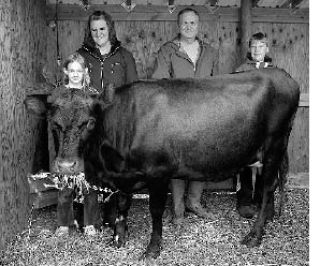June is “Dairy Month,” a designation begun in 1937 by the National Dairy Council as a way to encourage milk drinking and support dairy farmers. But before there were dairy associations promoting the milk, cream, butter, ice cream, yogurt and cheese we buy in markets today, many families had their own cow. And here on Lopez some still do.
Last month, I visited the Zapalac family, including Vera Lynn, the family cow. Keeping a family cow is certainly more effort than remembering to stop at the dairy aisle, but after meeting Vera Lynn and talking with David Zapalac about their life with a family cow I can understand why people do it.
Vera Lynn is a beautiful little cow. Standing about four feet tall, she has a shiny black coat with undertones of auburn, classic diary cow hips and a brown and white udder, all these qualities revealing her mix of Angus, Devon and Jersey breeding.
She’s calm and friendly, important traits in a family cow, and she likes to be milked by hand. “We took care of her for Nick and Sara Jones for a while,” David said, “and when we found out what a good milker she was, we bought her from them.”
Typically, a diary cow gives milk for nine or ten months of a year, from the time she gives birth, on to when she’s bred again two or three months later, and then on through the first six or seven months of her nine-month pregnancy. Then she’s dried off and not milked for two or three months until she gives birth and the milk production cycle starts again.
Vera Lynn was dried off early before the birth of her second calf, David told me. “Luckily, she had no problem calving, even though the bull calf was pretty good size. She just walked in here one day and had him in the middle of the day.”
For the next three months, the calf nursed and the Zapalacs adjusted the amount of milk they took based on the calf’s need. Now he’s weaned and eating grass. In a few years he’ll provide the family grass-fed beef.
“Now we’re milking Vera Lynn twice a day,” David continued. “It’s a big commitment, but a nice pace if you’re up for it. It’s really relaxing to just come out and sit with the cow.”
But there’s more to the job than just sitting with the cow. Cleanliness is crucial with milk. Before each milking, Vera Lynn gets brushed and her teats are washed with an iodine/glycerin mixture. “We’re always thinking about where our hands have been,” David added.
We toured the milking room where the cleanliness theme continued. There’s a sink dedicated just for milk. Above it is a clean shelf holding two stainless steel milking buckets with lids. “It is sort of an insurance deal to have two milk pails,” David explained. “When you’re half way done milking, you switch pails, just in case something drops in.”
In addition to drinking Vera Lynn’s milk, Zapalacs use it to make cheese, butter and ice cream. Pointing to his cheese making equipment, David said he likes to “sit here and read a book and stir things.”
In a speedier process, Diana Zapalac makes butter in the Cuisinart in seven minutes. And on the kitchen table is the ice cream maker his family used when David was a kid.
Heading outdoors again, we admired the pastures that stretch out from their home. “If you’re going to have a cow, you need to have pasture,” David said. “This grass diet is a key to a healthy cow. Vera Lynn eats a little alfalfa hay while being milked but she’s really a grass-fed cow. That’s another nice thing about mixed breed: they don’t have the nutrition requirements of a larger cow that’s bred for production.”
“We wanted some way we could take our pasture and convert it to food,” David concluded. “This is a really gentle way to do it.”
If you’re interested in having your own cow, David recommends reading Joann S. Grohman’s “Keeping a Family Cow,” and Lopez Library has Dirk Van Loon’s “The Family Cow” and Sara Rath’s “The Complete Cow.”
And for those of us who continue to get our milk in the diary aisle, remember this is “Dairy Month” and raise a glass in thanks to dairy farmers and their cows.



